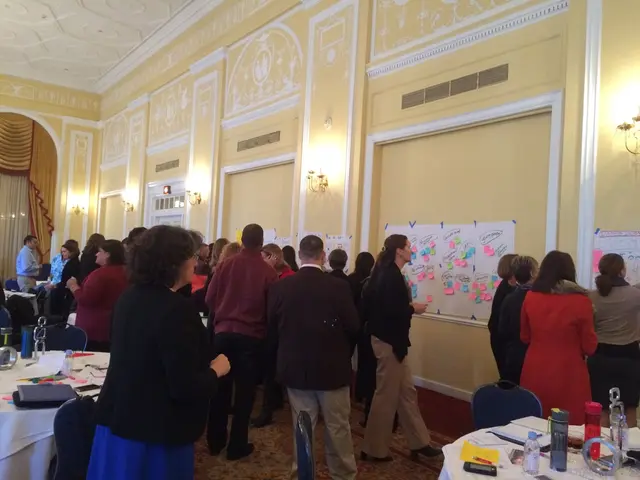Unexpected camaraderie: Japan and rural Estonia discover common ground in the role of Tartu as European Capital of Culture 2024
Rewritten Article:
- Empower your social media with Share294!
- Post on Twitter
- Connect on LinkedIn
- Drop us an email
In a stunning union of cultures, Japan and Estonia have formed an unlikely partnership, despite the vast distances and time zones that separate them. These two diverse nations have become influential sources of inspiration for artists, curators, and cultural enthusiasts in their respective countries, showcasing their unique artistic spirits in their collaborative works. The European Capital of Culture Tartu 2024 is gearing up for a spectacular year-long celebration packed with projects born from Estonian-Japanese collaborations.
This collaboration is made possible due to Japanese cultural policies that focus on global expansion and the sharing of their culture. Organizations like the EU-Japan Fest, which have been in operation since the 90s, support cultural exchanges between the European Union and Japan through funding projects and collaborations.
As Kati Torp, the Tartu 2024 artistic director, explains, the connections with Japan in the program have grown organically based on artistic decisions. "Our program showcases the results of years of labor. All of the major Japanese artists or projects have a pre-existing relationship with Estonia," Torp stated.
One of the highlights of the European Capital of Culture year in Southern Estonia is the highly anticipated audiovisual exhibition by Japan's leading electronic music composer and visual artist, Ryoji Ikeda, at the Estonian National Museum. This isn't the first time Ikeda's work has been showcased in Estonia, and the connection dates back to Torp's personal involvement in coordinating Ikeda's exhibition in 2015-2016.
Ikeda will create two new works specifically for Tartu 2024 in collaboration with the Estonian Biobank and the Estonian Philharmonic Chamber Choir. The installations and performances promise to shed light on complex scientific topics, blurring the line between technology and nature.
Võru County in Southern Estonia hosts the Aigu Om festival, a unique event celebrating the art of idling or "molutamine" in Estonian. This year's focus is on Japan and its culture. Tracing the roots of the festival, Estonian folk singer-songwriter Mari Kalkun, who has built a unique bond with Japan through her music, explains that the idea behind the festival is reflected in the local dialect of Võro—Aigu Om means "there is time" or "take time."
Over the course of a week, visitors can participate in workshops, contemplations, concerts, and hikes that immerse them in the rich local cultural heritage and the enchanting nature of Võrumaa, while experiencing various forms of art, music, and performance featuring both Japanese and Estonian artists.
For those eager to delve deeper into Japanese culture, Tartu 2024 offers a multitude of events: from Japanese forest bathing experiences, theater plays, to textile art installations, and more. By attending these events, you'll have the opportunity to experience the best of Japanese and Estonian cultures in a unique way.
Despite the differences between these two nations, it seems that there exists a mutual understanding and appreciation. The shared interest in nature, technology, and the intrigue towards each other's cultures have fostered a thriving and creative partnership.
While Estonia is relatively unknown in Japan, Estonian musicians, composers, and conductors like Arvo Pärt and Tõnu Kaljuste, have gained global recognition. This reputation paves the way for rising artists like Ryoji Ikeda to collaborate and be inspired by Estonia's unique cultural landscape and creative spirit.
Find out more about the European Capital of Culture Tartu 2024!
- Share294
- Tweet
Enrichment Data:
Overall:
The cultural partnership between Japan and Estonia is built on sustained diplomatic and community engagement, grassroots cultural exchanges, and institutional collaborations. Recent initiatives highlight several key aspects:
Diplomatic and Community Engagement
The Estonian Association of Former University Students of Japan hosts events at the Japanese Ambassador's residence and strengthens ties between the two nations. Parliamentary diplomacy, such as receptions for the Estonia-Japan Parliamentary Friendship Group, further cements institutional links [1]. Japan's participation in festivals like J-Tsoon, focusing on Asian subcultures, underscores efforts to reach younger audiences [1].
Cultural Resource Sharing
The Read Japan Project donates over 80 Japan-related books to Estonian libraries, promoting access to Japanese literature and scholarship at the grassroots level [1]. These donations aim to deepen understanding of Japanese culture and history.
Scholarship Opportunities
The MEXT 2025 Scholarship programs, actively promoted by Japan’s embassy in Estonia, facilitate academic exchanges, fostering long-term cultural and intellectual ties [1]. Such programs enable Estonian students to immerse themselves in Japanese society, contributing to cross-cultural dialogue.
These efforts collectively emphasize soft diplomacy through education, literature, and community-driven events, creating a foundation for sustained cultural exchange.
- The European Capital of Culture Tartu 2024's partnership with Japan showcases the unique artistic spirits of both nations.
- The European Union and Japan's cultural exchanges are supported by organizations like the EU-Japan Fest, which fund projects and collaborations.
- Kati Torp, Tartu 2024's artistic director, mentioned the organic growth of connections with Japan based on artistic decisions.
- Ryoji Ikeda, a leading electronic music composer and visual artist from Japan, will create new works for Tartu 2024 in collaboration with Estonian Biobank and the Estonian Philharmonic Chamber Choir.
- Võru County's Aigu Om festival celebrates art, music, and performance featuring both Japanese and Estonian artists, with a focus on Japan's culture this year.
- Tartu 2024 offers a variety of events for those interested in experiencing the best of Japanese and Estonian cultures, such as Japanese forest bathing experiences and theater plays.
- Yutaka, a user on LinkedIn, shared his experience attending cultural events during Tartu 2024, emphasizing the mutual understanding and appreciation between Japan and Estonia.
- Arvo Pärt and Tõnu Kaljuste, Estonian musicians and conductors, have gained global recognition, paving the way for collaborations with artists like Ryoji Ikeda.
- In 2024, the European Capital of Culture Tartu 2024 will showcase a year-long celebration of Estonian-Japanese collaborations in various fields, including fashion-and-beauty, food-and-drink, home-and-garden, travel, and education-and-self-development.
- To learn more about the European Capital of Culture Tartu 2024 and get updates on their upcoming events, follow them on Share294, Twitter, LinkedIn, or drop them an email.







